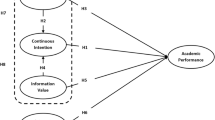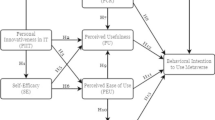Abstract
The aim of this study is to propose a theoretical model to examine consumer word-of-mouth (WOM) behavioural intention in Malaysian education services. The results from a survey of 247 respondents indicate that servicescape, service recovery, service quality and satisfaction significantly affect consumers’ intention to engage in WOM behaviour. The results support majority of the hypothesized relationships, suggesting that servicescape and service recovery function as antecedents, directly affecting consumer perceptions of education service quality. The analytical results also demonstrate that perceived service quality positively affects satisfaction, which subsequently induces consumers’ behavioural intentions. Consistent with previous empirical studies, our findings suggest that satisfaction is a super-ordinate construct with a positive relation to behavioural intention, and significantly mediates the effect of service quality on the intention to engage in WOM behaviour. The insignificant direct effect from service quality to WOM further suggests the role of satisfaction as a complete mediator in the university education service setting. Implications for future research are discussed and limitations noted.


Similar content being viewed by others
References
Abdullah F (2006) Measuring service quality in higher education: HEdPERF versus SERVPERF. Mark Intell Plan 24(1):31–47
Amin M, Isa Z, Fontaine R (2011) The role of customer satisfaction in enhancing customer loyalty in Malaysian Islamic banks. Serv Ind J 31(9):1519–1532
Baron RM, Kenny DA (1986) The moderator-mediator variable distinction in social psychological research: conceptual, strategic, and statistical considerations. J Pers Soc Psychol 51(6):1173–1182
Bitner MJ (1990) Evaluating service encounters: the effects of physical surroundings and employee responses. J Mark 54(2):69–82
Bitner MJ (1992) Servicescapes: the impact of physical surroundings on customers and employee. J Mark 56(2):57–71
Bitner MJ, Booms BH, Tetreault MS (1990) The service encounter: diagnosing favorable and unfavorable incidents. J Mark 54(2):71–84
Blodgett JG, Hil DJ, Tax SS (1997) The effects of distributive, procedural, and interactional justice on postcomplaint behavior. J Retail 73(2):185–210
Brady MK, Robertson CJ (2001) Searching for a consensus on the antecedent role of service quality and satisfaction: an exploratory cross-national study. J Bus Res 51(1):53–60
Caruana A, Money AH, Berthon PR (2000) Service quality and satisfaction: the moderating role of value. Eur J Mark 34(11/12):1338–1352
Chaniotakis IE, Lymperopoulos C (2009) Service quality effects on satisfaction and word of mouth in the health care industry. Manag Serv Qual 19(2):229–242
Cronin JJ, Taylor SA (1992) Measuring service quality: a reexamination and extension. J Mark 56(3):55–68
Dabholkar PA, Shepherd CD, Thorpe DI (2000) A comprehensive framework for service quality: an investigation of critical conceptual and measurement issues through a longitudinal study. J Retail 76(2):139–173
Day GS (1971) Attitude change, media and word of mouth. J Advert Res 11(6):31–40
File KM, Prince RA (1992) Positive word-of-mouth: customer satisfaction and buyer behaviour. Int J Bank Market 10(1):25–29
Fornell C (1992) A national customer satisfaction barometer: the Swedish experience. J Mark 56(1):6–21
Fornell C, Larcker DF (1981) Evaluating structural equation models with unobservable variables and measurement error. J Mark Res 18(1):39–50
Ghobadian A, Speller S, Jones M (1994) Service quality: concepts and models. Int J Qual Reliab Manag 11(9):43–66
Goyette I, Ricard L, Bergeron J, Marticotte F (2010) E-WOM scale: word-of-mouth measurement scale for e-services context. Can J Adm Sci 27(1):5–23
Grönroos C (1984) A service quality model and its marketing implications. Eur J Mark 18(4):36–44
Grönroos C (2007) Service management and marketing: customer management in service competition. Wiley, West Sussex
Hair JF, Black B, Babin B, Anderson RE, Tatham RL (2006) Multivariate data analysis. Pearson Prentice Hall, Englewood Cliffs
Harrison-Walker LJ (2001) The measurement of word-of-mouth communication and an investigation of service quality and customer commitment as potential antecedents. J Serv Res 4(1):60–75
Henry JW, Stone RW (1994) A structural equation model of end-user satisfaction with a computer-based medical information system. Inf Resour Manag J 7(3):21–33
Hess RL, Ganesan S, Klein NM (2003) Service failure and recovery: the impact of relationship factors on customer satisfaction. J Acad Mark Sci 31(2):127–145
Hua L-t, Bentler PM (1999) Cutoff criteria for fit indexes in covariance structure analysis: conventional criteria versus new alternatives. Struct Equ Model 6(1):1–55
Jain R, Sinha G, De SK (2010) Service quality in higher education: an exploratory study. Asian J Mark 4(3):144–154
Joreskog K, Sorbon D (1989) Lisrel VII: user’s reference guide. Scientific Software, Mooresvill
Kanapathy V (2003) Service sector development in Malaysia: education and health as alternative sources of growth. In: Proceedings of AT120 research conference, Tokyo, 20–21 February. Tokyo Club Foundation for Global Studies
Keaveney SM (1995) Customer switching behaviour in service industries: an exploratory study. J Mark 59(2):71–82
Kelly SW, Davis MA (1994) Antecedents to customer satisfaction for service recovery. J Acad Mark Sci 22(1):52–61
Kim HJ (2011) Service orientation, service quality, customer satisfaction, and customer loyalty: testing a structural model. J Hosp Mark Manag 20(6):619–637
Lopez J, Hart LK, Rampersad A (2007) Ethnicity and customer satisfaction in the financial services sector. Manag Serv Qual 17(3):259–274
Lovelock C, Gummesson E (2004) Whither service marketing? In search of a new paradigm and fresh perspectives. J Serv Res 7(1):20–41
Mattila AS (1999) The role of culture in the service evaluation process. J Serv Res 1(3):250–261
Mattila AS, Patterson PG (2004) Service recovery and fairness perceptions in collectivist and individualist contexts. J Serv Res 6(4):336–346
Maxham JG (2001) Service recovery’s influence on consumer satisfaction, positive word-of-mouth, and purchase intentions. J Bus Res 54(1):11–24
Mazzarol T, Sweeney JC, Soutar GN (2007) Conceptualizing word-of-mouth activity, triggers and conditions: an exploratory study. Eur J Mark 41(11/12):1475–1494
Miller JL, Craighead CW, Karwan KR (2000) Service recovery: a framework and empirical investigation. J Oper Manag 18(4):387–400
Oliver RL (1977) Effect of expectation and disconfirmation on postexposure product evaluations: an alternative interpretation. J Appl Phycol 62(4):480–486
Pandian A (2008) Multiculturalism in higher education: a case study of middle eastern students’ perceptions and experiences in a malaysian university. Int J Asia Pac Stud 4(1):33–59
Parasuraman A, Berry LL (1993) More on improving service quality measurement. J Retail 69(1):140–147
Parasuraman A, Zeithaml VA, Berry LL (1985) A conceptual model of service quality and its implications for future research. J Mark 49(4):41–50
Parasuraman A, Zeithaml VA, Berry LL (1988) SERVQUAL: a multiple-item scale for measuring consumer perceptions of service quality. J Retail 64(1):12–40
Paswan AK, Ganesha G (2009) Higher education institutions: satisfaction and loyalty among international students. J Mark High Edu 19(1):65–84
Preacher KJ, Hayes AF (2004) SPSS and SAS procedures for estimating indirect effects in simple mediation models. Behav Res Methods Instrum Comput 36(4):717–731
Reimer A, Kuehn R (2005) The impact of servicescape on quality perception. Eur J Mark 39(7/8):785–808
Ruiz-Molina M-E, Gil-Saura I, Moliner-Velazquez B (2011) Does technology make a difference? Evidence from Spanish hotels. Serv Bus 5(1):1–12
Shrout PE, Bolger N (2002) Mediation in experimental and nonexperimental studies: new procedures and recommendations. Psychol Methods 7(4):422–445
Stern BB (1994) A revised model for advertising: multiple dimensions of the source, the message, and the recipient. J Advert 23(2):5–16
Sultan P, Wong HY (2011) Service quality in a higher education context: antecedents and dimensions. Int Rev Bus Res Pap 7(2):11–20
Swanson SR, Kelly SW (2001) Service recovery attributions and word-of-mouth intentions. Eur J Mark 35(1/2):194–211
Sweeney JC, Soutar GN, Mazzarol T (2008) Factors influencing word of mouth effectiveness: receiver perspectives. Eur J Mark 42(3/4):344–364
Taylor SA, Baker TL (1994) An assessment of the relationship between service quality and customer satisfaction in the formation of consumers’ purchase intentions. J Retail 70(2):163–178
Ueltschy LC, Laroche M, Tamilia RD, Yannopoulos P (2004) Cross-cultural invariance of measures of satisfaction and service quality. J Bus Res 57(8):901–912
Vargo SL, Lusch RF (2004) Evolving to a new dominant logic for marketing. J Mark 68(1):1–17
Westbrook RA, Oliver RL (1991) The dimensionality of consumption emotion patterns and consumer satisfaction. J Consum Res 18(1):84–91
Willis M (2005) Why do students switch from one university to another: the view of students studying for a foreign degree in Hong Kong. J Mark High Edu 15(1):23–49
Zeithaml VA, Berry LL, Parasuraman A (1993) The nature and determinants of customer expectations of service. J Acad Mark Sci 21(1):1–12
Acknowledgments
Comments by Hanudin Amin, University Malaysia Sabah, to an earlier draft were helpful in revising this paper. The authors alone are responsible for all limitations and errors that may relate to the study and the paper. The useful and considered suggestions of two anonymous reviewers are acknowledged.
Author information
Authors and Affiliations
Corresponding author
Rights and permissions
About this article
Cite this article
Chang, H.H., Jeng, D.JF. & Hamid, M.R.A. Conceptualising consumers’ word-of-mouth behaviour intention: evidence from a university education services in Malaysia. Serv Bus 7, 17–35 (2013). https://doi.org/10.1007/s11628-012-0142-1
Received:
Accepted:
Published:
Issue Date:
DOI: https://doi.org/10.1007/s11628-012-0142-1




